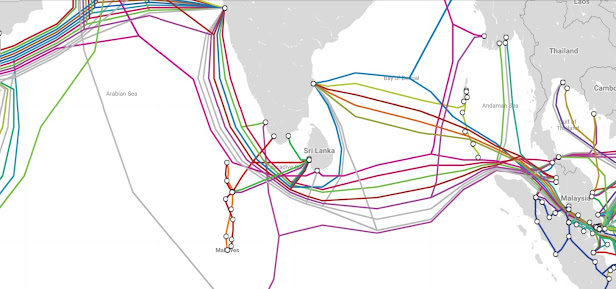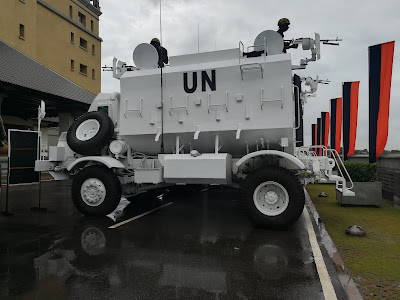SLAF to replenish training helicopters, other gaps in capability and capacity remains
An SLAF Bell-206 Jet Ranger in service with No.7 Squadron. Credit www.airforce.lk
By Asiri Fernando
The Sri Lanka Air Force (SLAF) will call for international bids to buy four used helicopters to replenish its aging training fleet in the near future.
The acquisition is to be made via competitive international bidding following government approval earlier this month.
Speaking to the press earlier this month (8 July), Co-Cabinet spokesman Romesh Pathirana said that President Gotabaya Rajapaksa on behalf of the Ministry of Defense had sought Cabinet approval to make the purchase. Pathirana pointed out that the SLAF needed to train pilots for UN peacekeeping missions.
According to Pathirana, the SLAF currently uses two helicopters manufactured in 1981 to train Pilots. The Jet Rangers first entered service in 1969, the Air Force website said. Several un-serviceable air frames rest at the Air Force Museum and are mounted as display aircraft at several air bases.
The two serviceable Jet Rangers are stationed at Higurakgoda Air Force Base and are part of the No.7 Squadron, which is also equipped with the Bell 212 helicopters. The Jet Ranger and Bell -212 have been the “”work horses” of No.7 squadron for several decades. The SLAF has been maintaining a dwindling fleet of 212's with a handful always kept operationally ready while the rest undergo servicing.
A SLAF Bell-212 helicopter of No.7 Squadron. Credit - www.airforce.lk
According to a senior defense official, the Air Force will acquire the same type (Bell -206) of helicopter (used) which will be cost effective and allow the utilization of technical expertise gained by the SLAF over the years, maintaining the Jet Ranger helicopters. The structures and resources are already at hand for the Jet Rangers .
Defence Asia reliably learns that the SLAF had also considered the new Bell- 505 'Jet Ranger X' helicopter as a possible option to replace the legacy Jet Ranger family with a new type. However, this option has not materialized.
The SLAF continues to operate Cessna-150 aircraft for basic flying training along with Chinese PT-6 (Chinese YAK-52 variant) at the No. 1 Flight Training Wing (FTW) stationed in China Bay AFB, Trincomalee. Like many small air forces world wide, the humble Cessna family continue to serve the SLAF well, though the basic trainer has begun to show its age. Six PT-6 trainers were purchased from China a few years ago, adding to the existing PT-6 fleet.
Cessna - 150 of the No.1 Flight Training Wing (FTW) Credit - www.airforce.lk
Gaps in capacity - opportunities lost and questionable priorities
While addition to the helicopter training fleet is necessary, there remain significant capacity gaps which need to be fulfilled.
In a 2014 report to the Parliament, the SLAF lists "Strategic and tactical aerospace surveillance and reconnaissance operations over Sri Lankan territory (inclusive of the EEZ)." as one of its core - competencies.
The SLAF at present lacks adequate Intelligence, Surveillance and Reconnaissance (ISR) and maritime patrol capability. Currently in service, the Beech 200 is the only aircraft equipped with day and night electro-optical payload. From the information available in the public domain, presently Sri Lanka lacks aircraft with capabilities such as surveillance radars, Signal intelligence (SIGINT) or Automatic Ship Identification (ASI transponder tracking) detection for maritime patrol duties.
The SLAF utilizes the Y-12 aircraft for reconnaissance duties with no specialized sensors onboard, depending on the old "MK I" eyeballs of the pilots and observers to carry out the task. In January, a Y-12 on a routine reconnaissance mission crashed near Haputhale, resulting in the death of four crew members.
A Second Beech King aircraft was acquired by the SLAF in 2009 and the US Government provided a "Real Time Data Link" to enable real time information sharing between surveillance assets and a ground control unit, which would support operational decision making on the go and deliver time critical intelligence and command capability to some extent. However, the second Beech King (SMR-2201) was not converted into a sensor platform and remains utilized for VIP transport and pilot training.
In 2014, the SLAF reported to the Parliament that it plans to "To induct 2 B 200 with surveillance equipment". However, in a 2015 report the SLAF states that "Installation of Maritime Surveillance Radar for Beechcraft is Postponed for future progress" while adding that the "Installation of Qty-01 Observation Payload for B-200 Beechcraft" has been proposed. However, there are no reports of a second purpose equipped aircraft in service as of 2020.
The need for strong ISR and Maritime Patrol Aircraft (MPA) capabilities has been a long felt need and has been highlighted by the SLAF at several defence symposiums over the years. The Sri Lanka Navy has also stated the need for MPA's to ensure better maritime domain awareness (MDA) over the years. However, a senior Navy officer told Defence Asia that when requested the SLAF conducts maritime surveillance missions and supports Navy “drug interception’ operations with the assets at hand.
The SLAF last year stood up No. 3 Squadron, aimed at reviving maritime patrol capability. Nevertheless, the lack of operational platforms which are suitably equipped to provide maritime surveillance over the required operational space, remains unchanged. There has been media reports of a possibility that the Indian Government may loan or sell Sri Lanka an Dornier 228 MPA. However, no decision has been made as talks on the matter continue between both countries.
The legacy unmanned platforms in SLAF service (UAV's) remain largely un-serviceable. The SLAF has been developing an indigenous UAS platform for several years and has been collaborating with a University to develop a locally sourced Data Link. While the project has matured over the years the platform has not entered service with the SLAF so far. The locally manufactured UAS will likely enter acceptance trails later this year (2020) an Air Force source told Defence Asia. As such, currently the SLAF's capability to provide effective ISR and Maritime Patrol remains inadequate.
Why consecutive SLAF leadership and Governments since 2009 failed to capitalize on a new air frame with a data down link, by converting the craft into a Maritime Patrol/ISR platform for over 10 years remains a mystery? For the Government of the time period the conversion would have been a cost effective alternative to buying a new family of MPA's.
The SLAF will send three AN-32B transport air craft to be overhauled in Ukraine in the coming months. Once the three aircrafts return, the SLAF will be able to revive a fixed wing transport capability as both C-130 air crafts remain grounded, pending overhaul. At present, a handful of Y-12 and one MA-60 aircraft, remain the only operational fixed wing air transport capability with the SLAF.
In 2014 the SLAF considered, establishing a Maintenance, Repair and Overhaul (MRO) facility in Sri Lanka, under the Russian line of credit. Progress of the proposed MRO facility is unknown. Had it been established, the SLAF could have overhauled close to a dozen Mi-17 and Mi-24/35 air-frames and saved a significant amount of foreign currency for the state, while giving SLAF engineers and technicians an opportunity to further their skills.
Operational capability gaps also remain in the air defence, helicopter and fighter roles, more on that in a later post.
The SLAF to their credit, has taken a leading role in cyber security of the country and has deployed on several peacekeeping missions, two of which are ongoing, with SLAF Mi-17 flying in UN colours across Africa. The force has also commenced overhaul of several Chinese built aircrafts at Katunayake, with support from the OEM.
The SLAF has also managed to utilize the dwindling fleet of Mi-17 and Bell-212 helicopters to respond to a number of natural disasters. Further, the SLAF has been steadily building up interoperability with the Navy. The last two years have seen SLAF Bell 412 helicopters test landing on SLN OPV's.
Over the years, the SLAF has embarked on many infrastructure projects, from upgrading personnel accommodation to holiday bungalows, golf links, hair salons and veterinarian facilities.
The SLAF continues to operate "Heli-tours" (a domestic flight service, subsidized by the state) using the operational Mi-17, Bell 212 - 412 and Y-12 air frames. There has been criticism of the SLAF run domestic carrier with questions raised about the suitability of the fixed wing aircraft employed to fly civilians and the insurance status of the aircraft.
Many private domestic carriers, including several organisations which have invested to bring in civilian helicopters, complain that "Heli-tours" is making their operations unprofitable, which raises the question about future investment in the domestic general aviation sector in the country.
While much has been done to meet the everyday needs of the manpower composition of SLAF, one has to question if somewhere along the road the SLAF is falling back to the pre-1971 pattern peacetime duties. If, like in 1971 and 1983, the SLAF's operational capability was found lacking at a future date. What lessons would we have learned from the costly episodes of the past?
There is little doubt that the SLAF has plans to modernize and be capable and ready on paper. However, ten years after the end of the Eelam wars, the SLAF has still far to go in bridging gaps in capacity and capability.
Sri Lanka has over the years spent a “lion's” share of its budget on the defence and security establishment. But it has failed to prioritize maintaining operational capability and operational availability in several key defence related fields. One can argue that an exception to this could be the Navy, which seem to have followed a strategic plan to adjust to the post war needs of the country to an extent.
The lack of an unified modernization plan for the armed forces, intelligence and law enforcement agencies has handicapped the Sri Lankan defence and security sector significantly. The Political, bureaucratic and military leadership over the last 10 years has failed to achieve synergy in policy and practice, thereby leaving Sri Lanka vulnerable at a time when stability and security is of vital importance.
The Easter Sunday Bombing of 2019 also highlights the need for defence and security sector reform. Reforming the system will be difficult: in particular, changing the outdated organisational cultures. Sri Lanka needs to take stock of her much celebrated defence and security apparatus and draft a long term defence and security policy with broad stakeholder participation.
A National Security Policy should be drafted by professionals and will need to be flexible to meet future challenges. It will also need to have a greater degree of transparency and accountability than the current structure, and be approved by the parliament.
END
END






Comments
Post a Comment